Physical Address
304 North Cardinal St.
Dorchester Center, MA 02124
Physical Address
304 North Cardinal St.
Dorchester Center, MA 02124
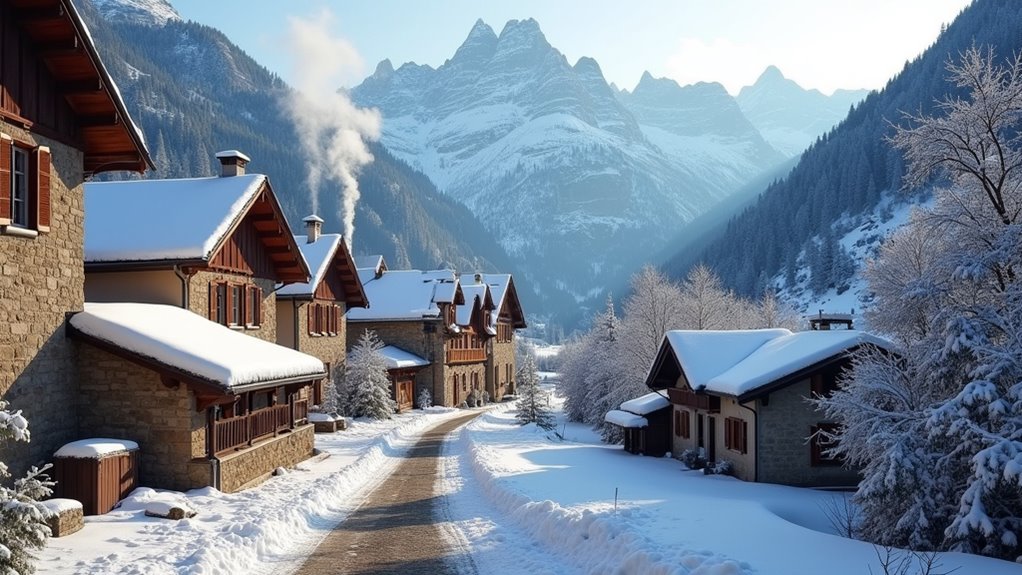
Looking for Italy's frostiest destinations? From Alpine Aosta to snowy Cuneo, these seven icy havens will surprise you.
Italy’s coldest cities include Aosta, with Alpine temperatures dropping to -17.6°C; Bolzano in the Dolomites, averaging -2.5°C in January; and Cuneo, the snowiest provincial capital with 110cm annual snowfall. You’ll also find extreme winter conditions in Belluno, Vercelli, and Celano, where temperatures plummet below freezing for months. The best time to experience these winter wonderlands is December through March, when you’ll enjoy ideal snow conditions and fewer travelers. Discover how these frosty gems reveal Italy’s unexpected side.
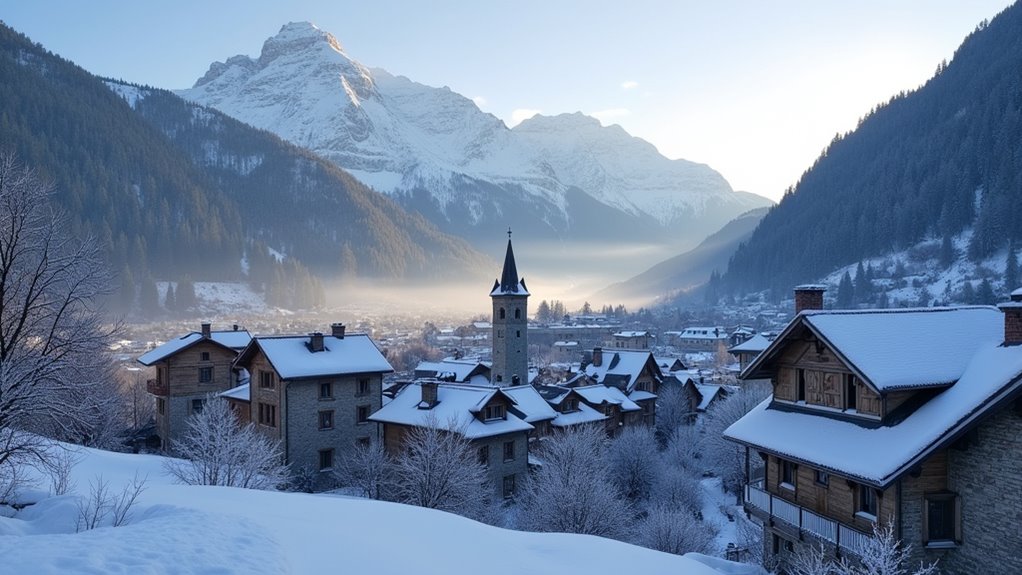
Nestled in the Aosta Valley and surrounded by towering mountains, Aosta experiences some of Italy’s coldest temperatures, with January averages hovering around -2.8°C and record lows plummeting to -17.6°C.
If you’re visiting during winter, you’ll find relatively dry conditions with infrequent but occasionally significant snowfalls. The valley’s unique geography creates thermal inversions when winds are weak, trapping cold air and intensifying the chill. The city’s climate is classified as temperate oceanic according to the Trewartha climate classification system.
Despite these frigid conditions, the surrounding mountains actually shield Aosta from extreme cold waves that affect more exposed regions. Aosta serves as an ideal Alpine gateway for travelers seeking Italy’s authentic cold-weather experience. You’ll notice temperature fluctuations when Atlantic currents bring milder periods, temporarily lifting temperatures above typical winter levels.
With annual precipitation around 550mm, Aosta remains less rainy than other Italian regions, though rainfall can be substantial when it occurs.
Surrounded by the magnificent Dolomites, Bolzano experiences winter temperatures that rival Arctic conditions, with January averages dipping to 27.5°F (-2.5°C).
Nestled beneath towering Dolomite peaks, Bolzano endures Arctic-like January cold, plunging to 27.5°F.
You’ll find winter is actually the driest season here, despite the cold.
If you’re visiting in December, expect daytime highs around 41°F with roughly 10 sunny days throughout the month.
Snowfall occurs annually but remains relatively rare, averaging just 30 cm per year.
When snow does fall, it’s typically carried by southerly winds.
Winter nights drop below freezing, while days warm slightly above 32°F. During particularly cold waves, night temperatures can drop to -5 to -7°C.
The cold season stretches from November through February, with significant cloud cover (about 48% overcast days) and occasional fog at night.
The nearby mountains dramatically influence these winter patterns.
Unlike Italian bucket-list spots such as Venice or Florence, Bolzano offers a truly alpine winter experience.
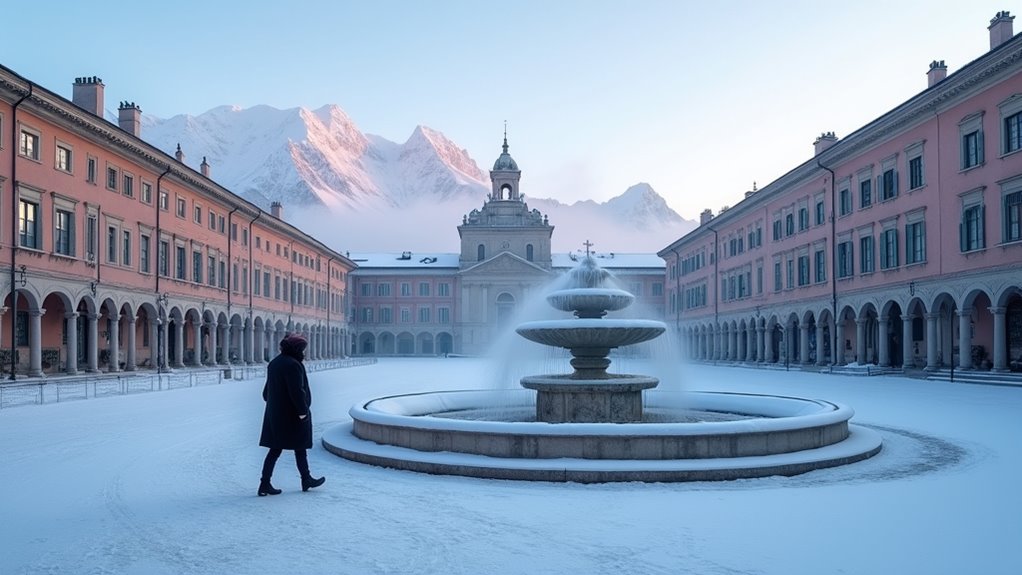
Located in the far northwestern corner of Italy, Cuneo has rightfully earned its reputation as the country’s frost capital. It’s the snowiest provincial capital in Italy, receiving an impressive 110 cm of snow annually.
During winter months, you’ll experience cold, humid conditions with temperatures averaging just 3.3°C in January. The city sits at 550 meters altitude on a plateau surrounded by mountains, contributing to its unique climate conditions.
The city’s extreme weather can be striking—in December 1990, residents witnessed one meter of snowfall in just 24 hours.
Winter temperatures can plummet dramatically, with records showing drops to -22°C at nearby Levaldigi airport in 2012.
If you visit during summer, you’ll enjoy more moderate conditions with July temperatures averaging 23.1°C.
Despite its frigid reputation, Cuneo offers a completely different experience than the warmth and vibrance of Bologna’s attractions found in northern Italy’s Emilia-Romagna region.
Regardless of when you visit, expect distinctive seasonal changes that local residents have adapted to through generations.
While the Veneto region is famous for Venice’s canals, Belluno distinguishes itself as its surprising cold spot. Nestled in a valley near the magnificent Dolomites, this city experiences a continental climate with significant seasonal variations.
With an average annual temperature of 9.2°C (48.5°F), Belluno showcases winter’s grip particularly in January, when temperatures average just 1.4°C. The valley position creates temperature inversions that trap cold air during winter months. Snow depth can reach impressive accumulations of up to 60 cm during extreme winter events.
Despite receiving substantial precipitation (1885mm annually), you’ll find the summer months quite pleasant, with July temperatures averaging 21.8°C. Local restaurants offer traditional cuisine that provides the perfect warming comfort after exploring the snowy landscapes.
If you’re planning a visit, pack accordingly for the season. Winter enthusiasts will appreciate the proximity to skiing areas, while summer offers perfect weather for exploring the UNESCO-listed Dolomites surrounding this charming cold spot.
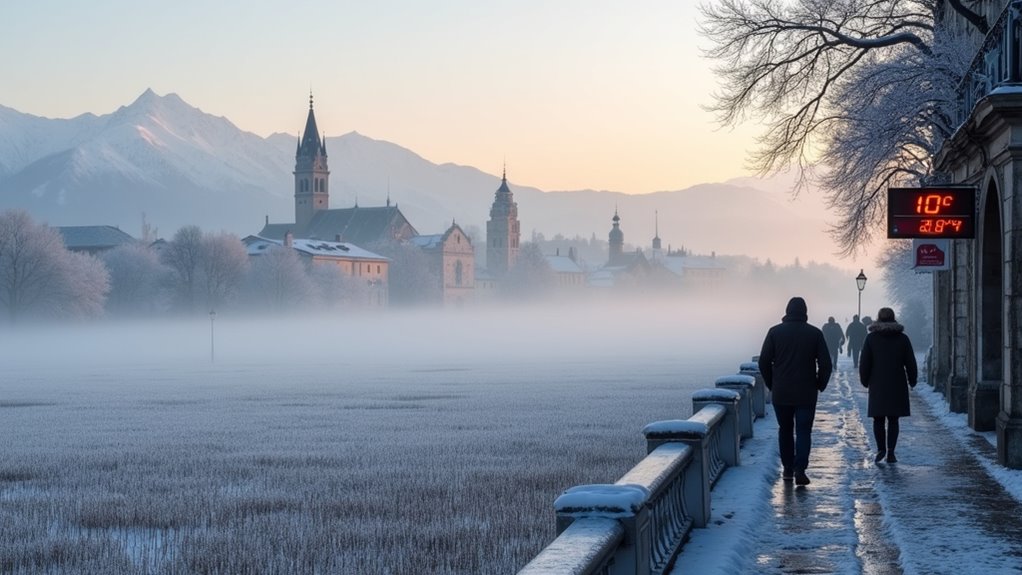
The frigid heart of Italy’s vast Po Valley reveals itself in Vercelli, where winter temperatures plummet to make it one of the country’s coldest inhabited regions. January averages a chilling 2.7°C, while July offers relief at 23.5°C.
Despite the cold, Vercelli’s climate shapes both its culture and economy:
Visitors should note that Vercelli, despite its beauty, can present unexpected dangers during winter months when ice forms on walkways and roads.
January stands out as the coldest month with lows reaching 31°F and limited daylight hours.
If you’re planning to visit, prepare for considerable seasonal variation—Vercelli delivers authentic northern Italian weather with all its extremes.
While the Po Valley has its frigid reputation, Celano takes Italy’s temperature extremes to another level. Nestled in the Apennine Mountains, this town experiences dramatic temperature plunges that can catch visitors unprepared.
January brings average lows of -0.8°C, but it’s the rapid nighttime drops that define Celano’s climate. The northeasterly Tramontana winds intensify winter cold snaps, creating windchill that feels markedly colder than thermometer readings suggest. Many travelers make the common mistake of packing insufficiently for these extreme conditions. The town experiences a significant snowy period lasting nearly 4 months from late November to mid-March, with January seeing the heaviest snowfall.
February’s persistent snowfall (averaging 106mm) blankets the landscape for weeks.
You’ll find Celano’s climate similar to Chester, California, with subalpine characteristics that create a shorter growing season than Italian lowland regions. Despite sharing Rome’s latitude, Celano’s 800m+ elevation ensures consistently colder temperatures and more reliable snowfall than other central Italian communities.
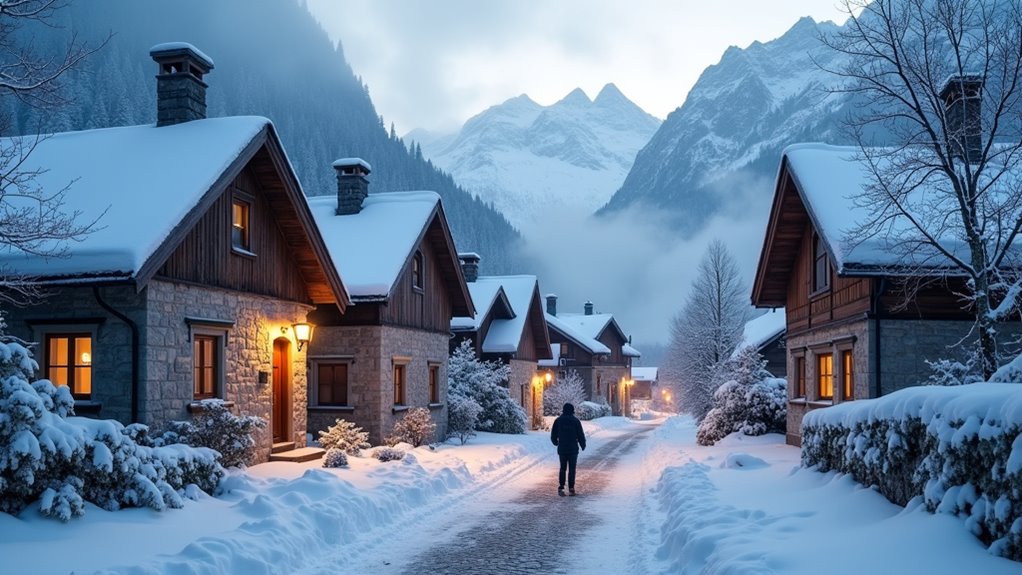
Despite Italy’s global reputation for sun-soaked Mediterranean coastlines, its coldest regions transform into winter wonderlands that draw thousands of travelers annually. If you’re planning a winter trip to Italy’s chillier destinations, timing is everything.
The best times to visit these frosty regions include:
You’ll find lower prices and fewer travelers during these winter months, making it ideal for both adventure seekers and budget travelers looking to experience Italy’s stunning snow-covered landscapes. While Italy’s coldest regions attract winter enthusiasts, those seeking Mediterranean warmth might prefer Sardinian beaches or the Amalfi Coast during summer instead. Winter visitors typically represent just a small fraction compared to the overwhelming crowds that flock to Italy during summer months.
You’ve now explored Italy’s most bone-chilling destinations where thermometers sometimes dip to -30°C. Like a fortress against summer’s relentless heat, these alpine towns offer invigorating escapes when the rest of the country swelters. Whether you’re seeking winter sports or simply a break from the Mediterranean sun, Italy’s coldest corners prove that this beloved country isn’t just about sandy beaches and sun-drenched vineyards.